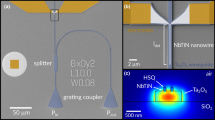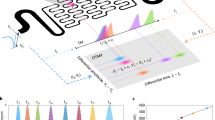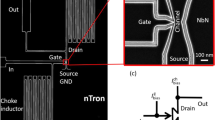Abstract
Superconducting nanowire single-photon detectors with peak efficiencies above 90% and unrivalled timing jitter (<30 ps) have emerged as a potent technology for quantum information and sensing applications. However, their high cost and cryogenic operation limit their widespread applicability. Here, we present an approach using tapered InP nanowire p–n junction arrays for high-efficiency, broadband and high-speed photodetection without the need for cryogenic cooling. The truncated conical nanowire shape enables a broadband, linear photoresponse in the ultraviolet to near-infrared range (~500 nm bandwidth) with external quantum efficiencies exceeding 85%. The devices exhibit a high gain beyond 105, such that a single photon per pulse can be distinguished from the dark noise, while simultaneously showing a fast pulse rise time (<1 ns) and excellent timing jitter (<20 ps). Such detectors open up new possibilities for applications in remote sensing, dose monitoring for cancer treatment, three-dimensional imaging and quantum communication.
This is a preview of subscription content, access via your institution
Access options
Access Nature and 54 other Nature Portfolio journals
Get Nature+, our best-value online-access subscription
$29.99 / 30 days
cancel any time
Subscribe to this journal
Receive 12 print issues and online access
$259.00 per year
only $21.58 per issue
Buy this article
- Purchase on Springer Link
- Instant access to full article PDF
Prices may be subject to local taxes which are calculated during checkout




Similar content being viewed by others
Data availability
The data that support the plots within this paper and other findings of this study are available from the corresponding author upon reasonable request.
References
Zhang, J., Itzler, M. A., Zbinden, H. & Pan, J.-W. Advances in InGaAs/InP single-photon detector systems for quantum communication. Light Sci. Appl. 4, e286 (2015).
Hadfield, R. H. Single-photon detectors for optical quantum information applications. Nat. Photon. 3, 696–705 (2009).
Chunnilall, C. J. et al. Metrology of single-photon sources and detectors: a review. Opt. Eng. 53, 081910 (2014).
Natarajan, C. M., Tanner, M. G. & Hadfield, R. H. Superconducting nanowire single-photon detectors: physics and applications. Supercond. Sci. Technol. 25, 063001 (2012).
Shin, D. et al. Photon-efficient imaging with a single-photon camera. Nat. Commun. 7, 12046 (2016).
Marsili, F. et al. Detecting single infrared photons with 93% system efficiency. Nat. Photon. 7, 210–204 (2013).
Altena, R., Perik, P. J., van Veldhuisen, D. J., de Vries, E. G. & Gietema, J. A. Cardiovascular toxicity caused by cancer treatment: strategies for early detection. Lancet Oncol. 10, 391–399 (2009).
El-Desouki, M. M., Palubiak, D., Deen, M. J., Fang, Q. & Marinov, O. A novel, high-dynamic-range, high-speed, and high-sensitivity CMOS imager using time-domain single-photon counting and avalanche photodiodes. IEEE Sens. J. 11, 1078–1083 (2011).
Tsang, J. C., Kash, J. A. & Vallett, D. P. Picosecond imaging circuit analysis. IBM J. Res. Dev. 44, 583–603 (2000).
Single Quantum Eos. SNSPD Closed-Cycle System (Single Quantum, 2018); http://singlequantum.com/wp-content/uploads/2018/08/Single-Quantum-Eos.pdf
Li, H. W. et al. Quantum dot resonant tunneling diode single photon detector with aluminum oxide aperture defined tunneling area. Appl. Phys. Lett. 93, 153503 (2008).
Rowe, M. A. et al. Single-photon detection using a quantum dot optically gated field-effect transistor with high internal quantum efficiency. Appl. Phys. Lett. 89, 253505 (2006).
Xia, F., Mueller, T., Lin, Y. M., Valdes-Garcia, A. & Avouris, P. Ultrafast graphene photodetector. Nat. Nanotechnol. 4, 839–843 (2009).
Koppens, F. H. L. et al. Photodetectors based on graphene, other two-dimensional materials and hybrid systems. Nat. Nanotechnol. 9, 780–793 (2014).
Konstantatos, G. et al. Hybrid graphene quantum dot phototransistors with ultrahigh gain. Nat. Nanotechnol. 7, 363–368 (2012).
Vallone, G. et al. Experimental satellite quantum communications. Phys. Rev. Lett. 115, 040502 (2015).
Bedington, R. et al. Nanosatellite experiments to enable future space-based QKD missions. EPJ Quantum Technol. 3, 12 (2016).
Oi, D. K. L. et al. Nanosatellites for quantum science and technology. Contemp. Phys. 58, 25–52 (2017).
Hu, L. & Chen, G. Analysis of optical absorption in silicon nanowire arrays for photovoltaic applications. Nano Lett. 7, 3249–3252 (2007).
Anttu, N. et al. Absorption of light in InP nanowire arrays. Nano Res. 7, 816–823 (2014).
Wallentin, J. et al. InP nanowire array solar cells achieving 13.8% efficiency by exceeding the ray optics limit. Science 339, 1057–1060 (2013).
Fountaine, K. T., Kendall, C. G. & Atwater, H. A. Near-unity broadband absorption designs for semiconducting nanowire arrays via localized radial mode excitation. Opt. Express 22, A930–A940 (2014).
Fountaine, K. T., Cheng, W. H., Bukowsky, C. R. & Atwater, H. A. Near-unity unselective absorption in sparse InP nanowire arrays. ACS Photon. 3, 1826–1832 (2016).
Azizur-Rahman, K. M. & LaPierre, R. R. Wavelength-selective absorptance in GaAs, InP and InAs nanowire arrays. Nanotechnology 26, 295202 (2015).
Namekata, N., Adachi, S. & Inoue, S. Ultra-low-noise sinusoidally gated avalanche photodiode for high-speed single-photon detection at telecommunication wavelengths. IEEE Photon. Technol. Lett. 22, 529–531 (2010).
Liang, Y. et al. Low-timing-jitter single-photon detection using 1-GHz sinusoidally gated InGaAs/InP avalanche photodiode. IEEE Photon. Technol. Lett. 23, 887–889 (2011).
Acerbi, F., Frera, A., Della, Tosi, A. & Zappa, F. Fast active quenching circuit for reducing avalanche charge and afterpulsing in InGaAs/InP single-photon avalanche diode. IEEE J. Quantum Electron. 49, 563–569 (2013).
Liu, J. et al. Fast active-quenching circuit for free-running InGaAs(P)/InP single-photon avalanche diodes. IEEE J. Quantum Electron. 52, 4000306 (2016).
Itzler, M. A., Jiang, X., Nyman, B. & InP-based, K. S. Negative feedback avalanche diodes. Proc. SPIE 7222, 72221K (2009).
Lunghi, T. et al. Free-running single-photon detection based on a negative feedback InGaAs APD. J. Mod. Opt. 59, 1481–1488 (2012).
Sze, S., Simon, M. & Kwok, K. N. Physics of Semiconductor Devices (Wiley, New York, 2006).
Zheng, D. et al. When nanowires meet ultrahigh ferroelectric field-high-performance full-depleted nanowire photodetectors. Nano Lett. 16, 2548–2555 (2016).
Bulgarini, G. et al. Avalanche amplification of a single exciton in a semiconductor nanowire. Nat. Photon. 6, 455–458 (2012).
Shen, L., Pun, E. Y. B. & Ho, J. C. Recent developments in III–V semiconducting nanowires for high performance photodetectors. Mater. Chem. Front. 1, 630–645 (2017).
Ko, W. S. et al. Ultrahigh responsivity-bandwidth product in a compact InP nanopillar phototransistor directly grown on silicon. Sci. Rep. 6, 33368 (2016).
VJ, L. et al. A perspective on nanowire photodetectors: current status, future challenges, and opportunities. IEEE J. Sel. Top. Quantum Electron. 17, 1002–1032 (2011).
Xu, Q. & Dan, Y. Uncovering the density of nanowire surface trap states hidden in the transient photoconductance. Nanoscale 8, 15934–15938 (2016).
Zhang, A., Kim, H., Cheng, J. & Lo, Y.-H. Ultrahigh responsivity visible and infrared detection using silicon nanowire phototransistors. Nano Lett. 10, 2117–2120 (2010).
Cui, Y. High-efficiency Nanowire Solar Cells. PhD thesis, Eindhoven Univ. Technology (2015).
Assefa, S., Xia, F. & Vlasov, Y. A. Reinventing germanium avalanche photodetector for nanophotonic on-chip optical interconnects. Nature 464, 80–84 (2010).
Saleh, B. E. A., Hayat, M. M. & Teich, M. C. Effect of dead space on the excess noise factor and time response of avalanche photodiodes. IEEE Trans. Electron Devices 37, 1976–1984 (1990).
Saleh, M. A. et al. Impact-ionization and noise characteristics of thin III–V avalanche photodiodes. IEEE Trans. Electron Devices 48, 2722–2731 (2001).
Senanayake, P. et al. Thin 3D multiplication regions in plasmonically enhanced nanopillar avalanche detectors. Nano Lett. 12, 6448–6452 (2012).
Farrell, A. C. et al. Plasmonic field confinement for separate absorption-multiplication in InGaAs nanopillar avalanche photodiodes. Sci. Rep. 5, 17580 (2015).
Logeeswaran, V. J. et al. A 14-ps full width at half maximum high-speed photoconductor fabricated with intersecting InP nanowires on an amorphous surface. Appl. Phys. A 91, 1–5 (2008).
Tosi, A., Calandri, N., Sanzaro, M. & Acerbi, F. Low-noise, low jitter, high detection efficiency InGaAs/InP single-photon avalanche diode. IEEE J. Sel. Top. Quantum Electron. 20, 1 (2014).
Namekata, N., Adachi, S. & Inoue, S. 1.5 GHz single-photon detection at telecommunication wavelengths using sinusoidally gated InGaAs/InP avalanche photodiode. Opt. Express 17, 6275–6282 (2009).
Ma, C. L. F., Deen, M. J. & Tarof, L. E. Multiplication in separate absorption, grading, charge, and multiplication InP–InGaAs avalanche photodiodes. IEEE J. Quantum Electron. 31, 2078–2088 (1995).
Brennan, K. Theory of the doped quantum well superlattice APD: a new solid-state photomultiplier. IEEE J. Quantum Electron. 22, 1999–2016 (1986).
Yue, A.-W., Wang, R.-F., Xiong, B. & Shi, J. Fabrication of a 10 Gb/s InGaAs/InP avalanche photodiode with an AlGaInAs/InP distributed Bragg reflector. Chin. Phys. Lett. 30, 038501 (2013).
van Dam, D. et al. High-efficiency nanowire solar cells with omnidirectionally enhanced absorption due to self-aligned indium-tin-oxide Mie scatterers. ACS Nano 10, 11414–11419 (2016).
Acknowledgements
S.J.G. and M.E.R. thank R. Ronaldo for help with the electronics set-up, J. P. Bourgoin for assistance with the optics and V. Zwiller for useful discussions. The authors also thank S. Kölling, who prepared the cross-sectional lamella by focused ion beam (FIB), and M. A. Verheijen, who performed the TEM analysis included in the Supplementary Information. The authors thank D. van Dam et al.51 for data used in Fig. 2b–d. This research was undertaken thanks in part to funding from the Canada First Research Excellence Fund and Industry Canada.
Author information
Authors and Affiliations
Contributions
S.J.G. performed the photocurrent testing. S.J.G., B.v.K., B.T. and M.E.R. wrote the manuscript, with input from all authors. D.v.D. and B.v.K. performed the optical measurements and simulations. B.T. performed the temperature-dependent dark current measurements and device simulations of the depleted nanowire core. Y.C. fabricated the devices. M.E.R. supervised the work. All authors approved the final version of the manuscript.
Corresponding author
Ethics declarations
Competing interests
The authors declare no competing interests.
Additional information
Journal peer review information: Nature Nanotechnology thanks Zhiyong Fan and other anonymous reviewer(s) for their contribution to the peer review of this work.
Publisher’s note: Springer Nature remains neutral with regard to jurisdictional claims in published maps and institutional affiliations.
Supplementary information
Rights and permissions
About this article
Cite this article
Gibson, S.J., van Kasteren, B., Tekcan, B. et al. Tapered InP nanowire arrays for efficient broadband high-speed single-photon detection. Nat. Nanotechnol. 14, 473–479 (2019). https://doi.org/10.1038/s41565-019-0393-2
Received:
Accepted:
Published:
Issue Date:
DOI: https://doi.org/10.1038/s41565-019-0393-2
This article is cited by
-
Lattice-mismatch-free construction of III-V/chalcogenide core-shell heterostructure nanowires
Nature Communications (2023)
-
Low-dimensional wide-bandgap semiconductors for UV photodetectors
Nature Reviews Materials (2023)
-
Semiconductor nanowire metamaterial for broadband near-unity absorption
Scientific Reports (2022)
-
High-performance HgCdTe avalanche photodetector enabled with suppression of band-to-band tunneling effect in mid-wavelength infrared
npj Quantum Materials (2021)
-
Avalanche photodetectors based on two-dimensional layered materials
Nano Research (2021)



